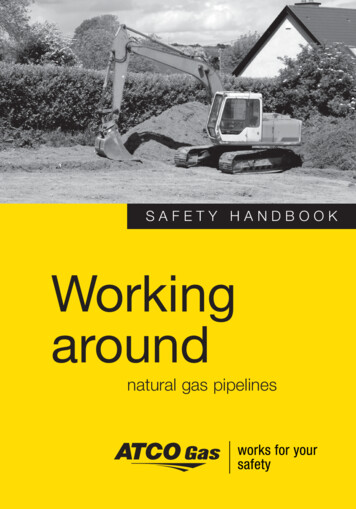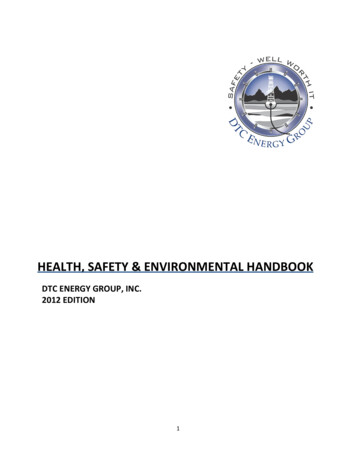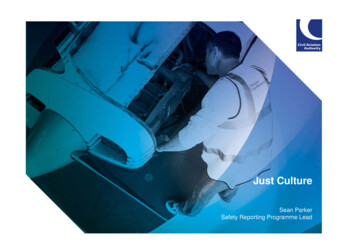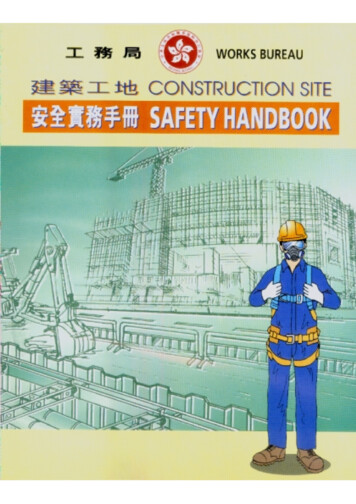
Transcription
SAFETY HANDBOOKWorkingaroundnatural gas pipelines
This safety handbook is foranyone who performs grounddisturbance work.Ground disturbance work includesbut is not limited to: digging augering directional drilling driving materials into the ground and/or professional excavationHow to use this safety handbookWHY IS SAFE GROUND DISTURBANCESO IMPORTANT?This handbook is divided into two major sections:Locating and Ground Disturbance.Contact with buried natural gas pipelines can leadto serious injury or death.Important information on what to do should you contact anatural gas pipeline is at the back of the handbook underHit and Blowing/Leaking Natural Gas Pipelines andNatural Gas Fires.Contacts also result in property damage that cancause interruptions in natural gas delivery to othersand be costly to repair.
Safety should always be yourfirst priority when working aroundnatural gas pipelines.The two most important steps to remember:2) Hand expose the natural gas line.1) Y ou must “Click Before You Dig” prior tobeginning ground disturbance work.Alberta One-Call will notify an ATCO Gasrepresentative, who will come to your worksite andidentify all natural gas lines in your work area.Contact: clickbeforeyoudig.com or 1-800-242-3447DYou must carefully hand expose the naturalgas line if you are disturbing the groundwithin one metre (three feet three inches)of the outside edges of the locate markings.Note: Hydrovacing is an acceptable methodof hand exposing.
CONTENTSSECTION 1 Locating underground facilities.2Contacting Alberta One-Call. 3Typical locate methods. 4FIG 1 - Temporary locate markings. 5FIG 2 - Definitions of markings (Int’l colour codes). 5What to do if the project gets delayed or revised. 7Ground disturbance.10Safety first. 11Ground disturbance near the hand expose zone. 12FIG 3 - Hand expose zone. 12Exposing methods. 13Hand exposure. 13Hydrovac. 13Excavation methods. 15Mechanical (incl. directional drilling/horizontal boring). 15FIG 4a - Directional drilling. 17FIG 4b - Directional drilling. 18Pipeline types. 19Polyethylene. 19Steel. 19Polyvinyl chloride. 19Aluminum. 19Temporary support systems. 20FIG 5 - Maximum length of unsupported pipe. 21FIG 6a - Pole supported pipe. 23FIG 6b - Plank supported pipe. 23FIG 6c - Truss supported pipe. 24Backfilling. 26SECTION 2Emergency procedures.28Hit and blowing/leaking gas lines. 29Environmental reporting. 29Natural gas fires. 30SECTION 31
CONTACTING ALBERTA ONE-CALLLocating undergroundfacilitiesThe Alberta Occupational Health and Safety Codestates you must contact Alberta One-Call tohave underground natural gas facilities locatedin your work area (clickbeforeyoudig.com or1-800-242-3447) before you begin work.SECTION 1SECTION 1This is a free service. (There may be a fee forunscheduled requests.)Alberta One-Call requires at least two fullworking days’ notice to do locates. Longweekends and other holiday periods tend to beactive times; therefore, more notice is required tomeet scheduling requirements.Alberta One-Call will arrange to have an ATCO Gasrepresentative come to your worksite and identify allnatural gas facilities in your work area.Remember that a main cause of hitting pipelinefacilities is failure to obtain an Alberta One-Calllocate request.!2Note: Some owners of buried utilities do notbelong to Alberta One-Call. They must becontacted directly by excavators requiring locates.Contacting Alberta One-Call first ensuresthat locates will be done by an ATCO Gasapproved utility locator agent who hasaccess to system mapping information.Note: All proposed excavation areas should beidentified in white3
TYPICAL LOCATE METHODSFIG 1 - Temporary locate markingsSECTION 11) T he locator will spray temporary paint markingson the ground and/or place locate flags in theground to indicate where natural gas facilitiesare buried. Natural gas markings are required tobe yellow.The paint markings indicate: the direction the pipeline runs the approximate location of the pipeline and/orother facilities (The depth of the facility willnot be provided)Locates are valid for 14 days from the date thelocate is completed.Locate markings may be shown by a singledashed line, flags, lath or pair of dashed linesconnected with a “V.” The “hand expose zone”(see Figure 3, p.12) extends one metre outwardfrom the marks. Figure 1 describes typical locatemarks. Figure 2 explains temporary markingdefinitions and the international colour code formarking buried facilities.FIG 2 - International colour code for markingburied facilitiesWHITEProposed excavationPINKTemporary survey markingsRED Electric power lines, cable conduit, lighting cablesYELLOW Gas, oil, petroleum, gaseous materialsORANGE Telephone, cable tv, communication, alarm, signal linesBLUEPotable waterGREEN Sanitary sewers, storm sewers, drain linesPURPLE Reclaimed water, irrigation, slurry lines45
!3) I f you are on the worksite when the locatoris finished identifying underground facilities,review the document with the locator.Ensure the locate document sketch matchesthe temporary paint markings and clearlyidentifies the work area.WHAT IF MY PROJECT GETS DELAYEDOR REVISED?What if my activity or weather disturbs thetemporary paint markings and/or flags?The person(s) requesting the locate is responsiblefor preserving the temporary paint markings and/orflags and protecting the marks from adverse weather.If the markings are no longer visible, you shouldarrange for new locates.SECTION 12) T he locator is required to provide you witha locate document. This document shouldinclude a sketch identifying the work area andthe type of facilities in the ground. You mayreceive this document in person, via fax or itmay be secured to one of the locate flags. (If thelocator determines that Polyvinyl Chloride (PVC)pipeline exists in your dig area, ATCO Gas mustsupervise any ground disturbance aroundthe pipeline. Please read more information onPVC pipeline on page 19, in the section calledFacilities – What You Will See in the Ground).Locates are valid for 14 days from the date thelocate is completed. Should your project bedelayed or revised beyond this date, you mayneed to cancel and reschedule your locates tomatch your new work start date.Locates expire after 14 days because: temporary paint markings eventually fade flags may be tampered with new utilities are constantly being installed existing utilities are often upgradedBe aware of the possibility of otherunderground facilities in your dig area(electricity, water, telephone, cable television, etc.).67
What if I have concerns about the locate?NOTES:!SECTION 1Please contact ATCO Gas Customer Assistancetoll-free at 780-310-5678 to discuss your concern.ATCO Gas is constantly striving to make excavationwork as safe as possible.Do not construct additions, garages,enclosed patios or decks over gas lines.Provincial regulations allow small, portable,free-standing garden sheds, provided nopermanent foundation is installed.Reporting in Calgary onlyA Calgary-based information support service existswhere you may report locating concerns involvingnatural gas, electric, telephone or water lines toone telephone number. Concerns in Calgary willbe investigated by the specific utility during normaloffice hours.After hours process: please leave a detailedmessage on the answering machine and theproblem will be investigated on the next businessday. The phone number is 403-245-7252.89
SECTION 2Ground disturbanceIt is extremely important to handexpose the natural gas line.You must carefully hand expose the naturalgas line if you are disturbing the ground withinone metre (three feet three inches) of theoutside edges of locate markings.Remember that a main cause of pipeline diggingaccidents is failure to properly hand expose thenatural gas line.It is always a good practice to assess whatpersonal protective equipment you shouldwear prior to beginning a work project.Consider: safety glasses gloves flame retardant coveralls steel-toed footwearSECTION 2SAFETY FIRSTFor ground disturbance work around naturalgas pipelines, you should conduct a hazardassessment to avoid injury and potentialnatural gas ignition.To ensure maximum safety, it is preferred thatground disturbance activities should be completedin frost-free conditions. Contact ATCO Gas priorto ground thawing when winter work is necessary.1011
Hand dig or hydrovac first; then use mechanicalexcavation.All ATCO Gas lines must be hand exposedbefore beginning any mechanical excavationactivity within the hand expose zone locatedone metre (three feet three inches) on eitherside of any locate marks.FIG 3 - Hand expose zoneEXPOSING METHODS1) Hand Exposure It is very important to hand expose thenatural gas line first. Use a shovel to expose the line to at least onemetre (three feet three inches) outward fromboth outside edges of the locate marks — this isthe hand expose zone.2) Hydrovacing A hydrovac is a fast, convenient and safemethod for exposing lines. A hydrovac combineswater pressure and a vacuum to excavate. It isespecially effective for exposing pipelines duringfrozen ground conditions. Hydrovacing can replace hand exposure asan acceptable digging method in the handexpose zone.SECTION 2GROUND DISTURBANCE NEAR THE HANDEXPOSE ZONENote: Hydrovac services are available for allsizes of excavation projects.Remember that improper hydrovac techniquesand equipment can damage natural gas lines.Continued on next page1213
Hydrovac Contractors Contractors must carry a Material Safety DataSheet (MSDS) for natural gas and be aware ofemergency procedures. Contractors are responsible for damage thatoccurs to a company pipeline during hydrovacexposing operations, including incidental damagessuch as gas loss, customer re-lights, firedepartment and dangerous goods response. Cover or barricade all open holes andexcavations until backfilling operationsare completed. Minor damage to the coating of a pipeline willbe repaired at no charge to the contractor.Contractors are required to provide adequateaccess to pipe for repairs and recoatingapplications.14 Contractors are responsible for the public’s safetyat excavation sites until inspection and backfillingis complete. If damage occurs, contractors must contact thenecessary authorities and ATCO Gas immediately.In an emergency, the operator may be asked torender assistance.EXCAVATION METHODS Use of mechanical excavation is permitted only afterthe facility is hand exposed. echanical excavation involves machinery that isMpowered by a pneumatic, electrical, or chemicalenergy source of operation. When excavating withmachinery (other than a hydrovac): two workers should always be present – themachine operator and a spotter remove small layers of soil in sequence dig parallel to the buried line wheneverpossible observe the excavation at all times formovement (e.g. cable contact), soilconsistency (trench line), or foreign objectsidentifying underground facilities. keep all mechanical excavation a minimumof 0.3 metres (one foot) away from all gaslines to prevent accidental contact with thegas line. Manually remove soil from the gasline areaSECTION 2Hydrovac Requirements Use a wand tip and suction hose covered withmaterial that will not damage the pipe – Teflon or rubber. Keep wand in motion at all times, with the wandtip at least 0.3 metres (one foot) from the line.Reduce pressure to finish the exposure. The wand tip should have a three-jet tip or anagitating spinner assembly. Do not exceed pressures of 1,500 PSI ortemperatures of 60ºC. Damage to the pipe or coating must be reportedto ATCO Gas.Continued on next page15
16DRPOFATHSECTION 2ROILLFIG 4b - Directional drilling inset on next pageDaylight an area of 0.3metres (minimum) to onemetre (preferred) all the wayaround the gas line.FIG 4a - Directional drillingParallel drilling: the excavator must expose anumber of points along the gas line by handor hydrovac when drilling within one metreof the outside edges of the gas line locatemarkings. This must be done to ensure that thegas line does not deviate from the associatedlocate marks. The number of exposure points isdetermined by the drill path and facility depth. Ata minimum, exposure points should occur every30 metres (98 feet) along the gas line. For jobsthat extend less than 30 metres (98 feet) along agas line, exposure points must occur more often.Visually inspectto ensure that thedrill-head/reamerdoes not contactthe gas line.Perpendicular drilling: the excavator mustexpose the gas line by hand or hydrovac tocreate a ‘daylighted’ area extending a minimumof 0.3 metres (one foot) on all sides around andbelow the pipe. A daylighted area of one metre(three feet) is preferred all the way around thepipe. Close visual inspection of the area belowthe pipe is required to ensure that thedrill-head/reamer does not hit the gas lineduring the initial push or the pull-back. The drillpath must cross under the pipe at the exact pointof exposure. Never assume that the gas linewill be at the same depth on either side ofthe exposure point.DDirectional drilling (horizontal boring)Directional drilling involves the use of mechanicalequipment to excavate by drilling horizontallybeneath the surface.17
18There are four types of ATCO Gas natural gasdistribution pipelines:1) Polyethylene (PE) a type of plastic pipe comes in various colours: yellow, black,orange, peach2) Steel (ST) appears as rough steel pipes or steel coated pipe(tar, grey paper, yellow jacket, blue, red, green)3) Polyvinyl chloride (PVC) a type of plastic pipe installed by ATCO Gas inthe mid-1960s comes in various colours: white, purple, grey,light blue, peach exposure of PVC lines requires thesupervision and direction of an ATCO Gascompany representative (please provide twofull working days’ notice to arrange for an inspector) crossing buried PVC lines with heavyequipment must be done followinginstructions provided by an ATCO GasrepresentativeSECTION 2NOTE: Visually inspect to ensure the reamer doesnot contact the gas line during pull back process.0.3 METRES (MINIMUM)CLEARANCE FROM REAMERREAMER0.3 METRESDAYLIGHT HOLEFIG 4b - Directional drillingGAS LINEDRILL RODGROUND LEVELFACILITIES - WHAT YOU WILL SEEIN THE GROUND4) Aluminum (AL) appears as light grey metal or covered with ayellow jacket accounts for less than one per cent of ATCOGas distribution pipeline in the province19
Mechanical couplings you may see a mechanical coupling on any part ofthe pipeline system a mechanical coupling is a fitting holding two endsof the pipeline together mechanical couplings can pose a safety issue if you expose a mechanical coupling,ensure the coupling is supported to restrictmovement. Call ATCO Gas as the mechanicalcoupling may require additional support.Sleeves are installed to protect sections of the pipelineand fittings common colours: black, brown, yellowWHAT IS A TEMPORARY SUPPORT SYSTEMAND IS IT REQUIRED?A temporary support system is a structure usedto prevent sag, bending or deflection in pipelinesduring excavation and backfill. It is usually astructure made of steel or wood.The length of the natural gas pipeline to beundermined is the determining factor on whethera temporary support system is required.FIG 5 - Maximum length of unsupported pipePIPE SIZESTEEL SPANPRESSURIZEDUNPRESSURIZEDPE 0(10)26.7(3/4)2.0(6.5)1.5(5)3.0(10)42.2(1 .5)508.0 (20 )8.7(28.5)SECTION 2Other facilities:Note: Maximum length of unsupported PVC pipeis 1.5 metres (5 feet).Figure 5 lists the maximum span of pipeline that canbe undermined without supports:2021
Note: An ATCO Gas representative must inspecttemporary support systems.FIG 6a - Pole supported pipeSPACING AS PER FIGURE 5MIN. 1mMIN. 1mSECTION 2If a temporary support system is required: supports must be installed prior to excavatingbelow the pipeline discuss the method and materials to be used withan ATCO Gas representative the property owner or contractor is responsiblefor supplying all material, labour and equipmentrequired b eam(s) placed across the excavation shouldextend at least one metre (three feet three inches)on either side of the trench, and the pipelineis to be attached to the support beam(s) withnylon slings retaining strips, NOT CHAINS, atintervals no greater than the maximum span ofunsupported pipe, as shown in Figure 5FIG 6b - Plank supported pipeFigures 6a, 6b and 6c are examples of excavatedpipeline with a temporary support system.MIN. 1mMIN. 1mGAS PIPELINERETAINING STRIP89 x 89 mm (4 x 4”)OR LARGER PLANKOR PIPE SPLITLONGITUDINALLY ANDPLACED UNDER PIPE2223
FIG 6c - Truss supported pipeSupport systems for parallel trenchesSupports are required if the distance from the pipeto the nearest wall of the proposed trench is lessthan the depth of the proposed trench. Pleasecontact ATCO Gas for the support systemdesign information.SPACING AS PER FIGURE 5SECTION 2MIN.300 mmMIN. 1mGAS PIPELINERETAINING STRIP89 x 89 mm (4 x 4”)OR LARGER PLANKOR PIPE SPLITLONGITUDINALLY ANDPLACED UNDER PIPEMATE RIALS1. 89 x 89 mm (4 x 4”) OR LARGER TREATEDPLANK WITH RETAINING STRIPS2. 89 x 89 mm (4 x 4”) TREATED POST3. 89 x 184 x 610 mm (4 x 8 x 24”)4. 38 x 89 mm (2 x 4”) ANGLE BRACESWhat to do if you contact a natural gas pipelineand there is no apparent gas leakReport all contacts to ATCO Gas. This includes allcontact with pipeline, coatings and tracer wire.Contact may cause damage upstream or downstreamthat can result in a leak that will require immediateattention.2425
FOR DEEP EXCAVATIONS WITH PIPESUPPORTS1) Call ATCO Gas for local pipe inspectionrequirements prior to backfill.2) Compact the fill under the pipe to providesupport and prevent stress.!3) Requirements governing depth of cover afterbackfilling are specified by individualmunicipalities; however, certain minimumrequirements are legislated provincially: excavation and backfilling activities shouldneither remove nor add to the depth ofcover without ATCO Gas permission use clean, lump-free material to coverthe natural gas pipeline do not place frozen dirt, rocks or lumpsdirectly on the natural gas pipeline4) When backfilling with filcrete, use a two stepprocess. The first mix is brought up tp 0.3 metres(1 foot) below the pipe and allowed to harden. Thepipe is then sand-padded with a minimum of 15centimetres (six inches) of cover. A second mix offilcrete then completes the backfill.!26!ATCO Gas must inspect deep excavation backfillsbefore the natural gas pipeline is concealed.Please call ATCO Gas when the backfill is within15 centimetres (six inches) of the pipeline. This willhelp the ATCO Gas representative safely inspectthe pipeline and repair any coating damage thesupport system may have caused.Backfill must be compacted to provide supportfor the existing pipe.Remember that it is important to carefully replacethe ground that you disturbed during the backfillingprocess. Your work should ensure that it does notinterfere with the integrity of underground naturalgas facilities.SECTION 2WHAT DO I NEED TO KNOW ABOUTBACKFILLING?Note: Compaction of backfill may be required,especially for high traffic locations. Contact anATCO Gas representative to help determinewhen compaction is needed and how it shouldbe done.Please contact ATCO Gas if you discover anatural gas pipeline with less than 0.6 metres(two feet) of cover.27
SECTION 3Emergency proceduresEMERGENCY PROCEDURES FOR HITAND BLOWING/LEAKING NATURALGAS PIPELINES1) C lear all people from the vicinity of the naturalgas leak.2) S hut-off or extinguish any source ofignition including equipment and vehicles,communication equipment including cellphones, cigarettes and/or open flames.3) Contact ATCO Gas for help.ATCO Gas emergency numbers:Edmonton and area780-420-5585Calgary and area403-245-7222All other areas1-800-511-3447STOPDo not attempt to repair the leak. Allow thenatural gas to vent into the atmosphere.(Attempting to repair the leak yourself can resultin property damage and serious injury to yourselfand others.)SECTION 34) R emain a safe distance away from the leakwhile you wait for assistance.Provincial legislation requires that the personresponsible for causing the natural gas releasenotify Alberta Environment at the first availableopportunity. Call toll-free 1-800-222-6514.2829
NATURAL GAS FIRESNOTES:1) Clear all people from the vicinity of the fire.2) C ontact the fire department and ATCO Gasimmediately.3) S tay a safe distance away from the fire whileyou wait for the fire department.Beware of static electricity Static electricity is a stationary electrical chargeon an object generated by friction. Static electricity in the pipe or in your clothescan be a source of ignition around natural gasfacilities. An accumulation of static electricitycan cause a spark.30SECTION 3Do not attempt to extinguish natural gas fires!31
For more information:For more information on working around natural gas or forservice pipeline applications, please contact ATCO Gas.Edmonton10035 – 105 StreetEdmonton, AB T5J 2V6780-420-7211All other 09 – 11 Avenue SWCalgary, AB T2R 1L8403-245-7110
CONTACTING ALBERTA ONE-CALL The Alberta Occupational Health and Safety Code states you mustcontact Alberta One-Call to have underground natural gas facilities located in your work area (clickbeforeyoudig.com or 1-800-242-3447) before you begin work. This is a fre










